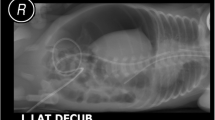Abstract
Among 36 neonates with intestinal perforations (IP) between 1975 and 1996, 5 had necrotizing enterocolitis (NEC IP) and 10 had focal IPs (FIP). A histologic review of the bowel near the perforations was made to see if there was any difference between cases of NEC IP and FIP. In 1 case of NEC IP, a defect in the musculature was found in addition to disappearance of the mucosal villi and dilated vessels or hemorrhage in the submucosa. Thinning or absence of the intestinal musculature and short villi in the mucosa was observed in 3 cases of FIP, but the acute ischemic changes in FIP were much less than in NEC IP. Hypothesizing that the defective musculature in FIP may be acquired by a vascular accident either before or after birth, we examined the histology of the latest consecutive infants diagnosed as having meconium peritonitis (MP) due to in-utero volvulus and perforation. In the tissue near the perforation, there was an identical focus of thinning and interruption of the musculature while the acute ischemic changes were minimal. We speculate that thinning or absence of the intestinal musculature in FIP may be a result of a transient ischemic event occurring in-utero and that FIP may develop in the damaged intestine after birth when it is fully dilated.
Similar content being viewed by others
Author information
Authors and Affiliations
Additional information
Accepted: 1 September 1998
Rights and permissions
About this article
Cite this article
Tatekawa, Y., Muraji, T., Imai, Y. et al. The mechanism of focal intestinal perforations in neonates with low birth weight. Pediatr Surg Int 15, 549–552 (1999). https://doi.org/10.1007/s003830050668
Issue Date:
DOI: https://doi.org/10.1007/s003830050668




